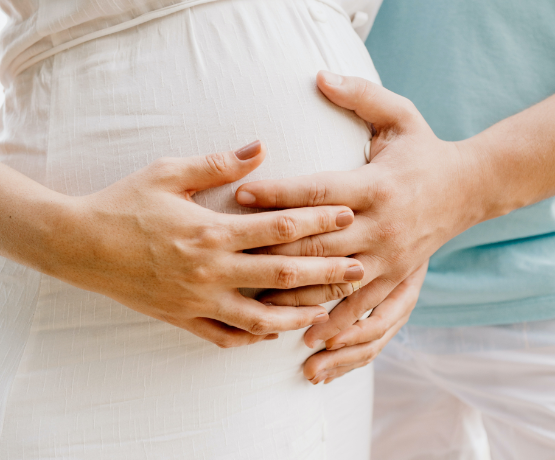Taking Control of Your Fertility with Toxin Awareness & Simple Lifestyle Changes
In our modern world, it’s no secret that often we’ve exchanged convenience for human health. More and more research is coming out with information about how our man-made environment creates issues in our bodies. Female fertility, of course, is one of these issues. But toxins actually affect sperm quality and sperm counts in men, too! For example, a landmark study published in 2017 found that sperm counts among men in Western countries had dropped by more than 50% over the past four decades. (1) While the exact causes are still being studied, many researchers believe that increased environmental exposures may be a significant contributing factor.
Throughout this article, we’ll explore how these toxins affect both male and female fertility and provide strategies for minimizing exposure and improving reproductive health for both partners.
Our clients often feel a bit overwhelmed at the thought of talking about toxins. They soon discover how empowering it is to understand that with the right health information, you have the ability to control many environmental factors and decrease your toxic burden substantially, which can boost fertility.
Yes, you have control over a lot of factors that can be problematic for fertility. And that’s very good news!
Below, we break down the two main categories of toxins – internal and external – and their adverse effects on fertility. Plus, we’ll explore what you can do to avoid these toxins and reverse their impact to amplify reproductive health.
Internal Toxins & Solutions
Most people understand that hormonal health is essential to reproductive functions for both men and women. Hormones naturally fluctuate, but there are many internal factors that can create toxin-like effects and throw off your rhythms.
Internal Toxin #1: Stress
There is a very strong connection between stress and fertility. In fact, stress has one of the biggest toxic impacts on our bodies. It’s an internal toxin that can increase our cortisol level, cause physiologic abnormalities in the systems of our body, and negatively impact reproductive hormones.
Common stressors affecting males and females include work-related pressures, financial concerns, and family responsibilities. For women, additional stressors might include hormonal fluctuations and caregiving roles, while men often experience stress from societal expectations and career demands.
What Can You Do?
In a world full of demands, having a stress management plan is absolutely key in preventing stress from negatively impacting your health.
Incorporating a practice into your everyday life will help how you respond to that stress. Restorative activities such as meditation, guided imagery, breathing techniques, gratitude, journaling, and mindfulness are proven science-backed ways to actually make a difference internally. By putting your body into a parasympathetic state, this will have a calming effect not only on your neurochemistry (state of mind), but also help to balance hormonal and immune function.
The brain is not static; instead, it continuously forms new connections between neurons, which is called neuroplasticity. It can actually be trained to be stronger and more resilient to stressors around us. You can actually learn to be healthier, happier, and more connected, but you must make a conscious effort to do so.
Adapting a daily restoration process into your routine will allow you to train your brain to receive the stress around you differently. The biochemical changes that occur in the body as a result of stress can be changed if the perception of stress changes. So, select a stress management tool that you enjoy and can practice daily. Find what works best for you and stick with it to reduce the impact of this internal toxin on your system.
When you effectively manage stress, you create a more balanced environment for your reproductive hormones, improving your fertility. By lowering cortisol levels and promoting hormonal harmony, you enhance your chances of conceiving and sustaining a healthy pregnancy.
Internal Toxin #2: Poor Sleep
Having elevated stress also impacts our sleep, which can increase internal toxins. Inadequate sleep has been shown to disrupt the balance of reproductive hormones, leading to reduced fertility in both men and women. (2) Quality sleep needs to be prioritized, as it is absolutely critical to both reproductive health and overall well-being. Research indicates that women who sleep less than seven hours a night are more likely to experience irregular menstrual cycles and difficulties in conceiving. (3) At night, your body is hard at work “cleaning up,” rejuvenating cells, and restoring dysfunctional biochemical processes that may be occurring in the body.
What Can You Do?
The stress management techniques mentioned contribute to better sleep, but there are other intentional practices you can do daily to improve the quality of sleep as well – using blue-blocking glasses when looking at devices, getting off your screens 1-2 hours before bedtime, keeping your room dark and cool (think 68 degrees Fahrenheit), and trying to have a similar sleep schedule or routine daily. Each of these will support your quest for better sleep and reduce your toxic burden.
Internal Toxin #3: Imbalanced Emotions
Emotional stress can negatively impact your health and fertility. For instance, chronic anxiety and depression elevate stress hormone levels, particularly cortisol, which can disrupt the delicate balance of reproductive hormones such as estrogen, progesterone, and testosterone. This hormonal imbalance can lead to irregular menstrual cycles, ovulation issues, and reduced sperm quality in men. Additionally, depression is associated with inflammation and oxidative stress, both of which can impair fertility by damaging reproductive cells and tissues and may exacerbate conditions like uterine fibroids that can affect fertility. (4)
What Can You Do?
If emotional imbalance is fairly common for you, you must take it seriously, not just for your own mental well-being but for your overall health. Find a therapist that you can work with and recognize that there is a lot you can do to change your baseline emotional state: Diet, exercise, mindset, and stress management techniques are just a few of the many ways to rebalance the mind. We actively work with all of our clients and patients to ensure a successful relationship with mindfulness is cultivated, which, in turn, expedites the healing process and optimizes fertility.
Internal Toxin #4: Nutrient Deficiencies
Nutrition plays a crucial role in both fertility and detoxification. These days, it’s virtually impossible to get all the nutrients we need due to modern farming practices, poor soil quality, and the pervasiveness of convenience foods. This leads many people to inadvertently become nutrient deficient. In fact, a comprehensive review published in Nutrition Reviews found that many women of reproductive age have inadequate intakes of crucial nutrients such as folate, vitamin D, and iron. These deficiencies can significantly impact fertility and pregnancy outcomes. (5)
What Can You Do?
While everyone’s nutrition status is different, there are certain nutrients known to help couples get and stay pregnant:
- Antioxidants – Foods rich in antioxidants like vitamins C and E, beta-carotene, and selenium can help protect eggs and sperm from oxidative stress caused by toxins. Good sources include berries, leafy greens, nuts, and seeds.
- Omega-5 fatty acids – These healthy fats, found in fish, flaxseeds, and walnuts, can help reduce inflammation and support hormone balance.
- Folate – This B vitamin is crucial for fetal development and may also improve fertility. Leafy greens, legumes, and fortified grains are good sources.
- Fiber – A high-fiber diet can help eliminate toxins from the body. Aim for a variety of fruits, vegetables, and whole grains.
It’s a good idea to confer with a functional fertility specialist who can run specific labs to identify your nutrient gaps. Your test results help us create a custom-tailored protocol to optimize your conception chances.
External Toxins & Solutions
External toxins are a very, very big category that impacts fertility, and we focus on this a lot with our work because it absolutely does affect your ability to get and stay pregnant. So again, don’t be overwhelmed by it, but start by understanding what you can change to decrease your toxin load.
External Toxin #1: Heavy Metals
Heavy metals are one of the biggest offenders to wreak havoc on fertility. The most common ones include cadmium, mercury, lead, and aluminum. There have been numerous studies on this topic, but there’s one study of infertile couples that stands out. They assessed whether preconception exposure to lead, mercury, and cadmium affects IVF outcomes and found that increased cadmium levels were associated with decreased egg fertilization and embryo implantation. (6)
Cadmium is found in rechargeable batteries, plastics, organ meats, paints, tobacco, smoke, and pesticides that are on our produce. Elevated levels can lead to emotional issues, low birth weight, and smaller head sizes in children. In men, it’s been linked to decreased sperm quality, sperm motility, and testosterone levels. In women, it can lead to irregular menstrual cycles.
Mercury is a neurotoxin that’s linked to slow IQ, poor language, and motor development.
Mercury is found in some face lotions that are made outside the United States, in older thermometers, and in our water as an industrial byproduct. Mercury is also why women are told to avoid certain fish when trying to get pregnant, such as king mackerel, shark, swordfish, marlin, orange roughy, and tuna. These should be avoided, not just in breastfeeding and pregnant women, but also in the preconception period. Since fish is an important source of protein, healthy fats, and omega-3 fatty acids, we suggest safer seafood options such as salmon and shrimp.
Lead is another one of the heavy metals with severe implications for fertility and overall health. Lead is commonly found in old paint, contaminated water, soil, and certain cosmetics. Lead exposure has been linked to a variety of reproductive issues, including decreased sperm counts in men and reduced ovarian function in women. This toxic metal can disrupt the endocrine system, leading to hormonal imbalances that impair fertility. (7) Additionally, lead exposure during pregnancy can increase the risk of miscarriage, preterm birth, and fetal development issues, making it critical to avoid during both the preconception and pregnancy periods.
Aluminum is also a metal that poses potential risks to reproductive health, though it is often overlooked. Common sources of aluminum include cookware, food packaging, antiperspirants, and certain medications such as antacids. While not as heavily studied as lead or cadmium, research suggests that aluminum can accumulate in the reproductive organs, leading to oxidative stress and inflammation, which may impair fertility. (4) Aluminum exposure has been associated with disrupted hormone levels, including those critical for reproductive function, such as estrogen and progesterone. Reducing aluminum exposure is particularly important during the preconception period, as it can negatively affect both male and female fertility.
What Can You Do?
For those planning to conceive, it’s essential to minimize exposure to heavy metals. This usually means paying attention to toxic chemicals in the items you buy and put on your body so you can avoid the ones with heavy metals.
For instance, ensure your home environment is free from lead-based paints, use water filters to reduce lead content in drinking water, and avoid consumer products known to contain lead. To minimize exposure to aluminum, choose aluminum-free personal care products, stop using aluminum cookware for acidic foods, and be mindful of food packaging materials.
External Toxin #2: Pesticides
Pesticides are a huge topic and something we can control. These toxic chemicals are designed to kill pests but can have unintended consequences on human reproductive health.
Estimates have shown that 90% of the population has detectable levels of pesticides in their blood and urine samples. (8) This widespread exposure is primarily due to residues on food and environmental contamination.
We know that preconception and pregnancy pesticide exposure to toxic chemicals like glyphosate can impact the health of the mother and baby. Studies have linked pesticide exposure to various reproductive health issues, including:
- Reduced fertility – Both male and female fertility can be affected by pesticide exposure
- Increased risk of miscarriage – Some pesticides have been associated with a higher risk of pregnancy loss
- Fetal developmental issues – Exposure during pregnancy may lead to developmental problems in the fetus
What Can You Do?
To reduce your pesticide exposure, always buy organic produce on the Dirty Dozen list. The Environmental Working Group comes out every year with a list of the top 12 foods that are most impacted by pesticides, and buying these organic foods can make a big difference in decreasing your toxic burden. We also recommend buying organic berries whenever possible.
External Toxin #3: Endocrine Disruptors
Endocrine disruptors are chemicals that can interfere with the body’s endocrine system and produce adverse developmental, reproductive, neurological, and immune effects in humans. These toxic chemicals can be found in many everyday consumer products, including plastic bottles, metal food cans, detergents, flame retardants, food, toys, cosmetics, and pesticides.
Some common endocrine-disrupting chemicals include:
- Bisphenol A (BPA) – Found in plastic containers and can linings, BPA can mimic estrogen and disrupt hormone balance.
- Dioxins – Industrial byproducts that can accumulate in the food chain and interfere with reproductive health.
- Perchlorate – A contaminant found in drinking water that can affect thyroid function.
- Perfluoroalkyl and Polyfluoroalkyl Substances (PFAS) – “Forever chemicals” used in non-stick cookware and water-resistant consumer products that can impact fertility.
- Phthalates – Plasticizers found in personal care products that can disrupt hormone production.
- Phytoestrogens – Plant-based compounds that can mimic estrogen in the body.
- Polybrominated diphenyl ethers (PBDEs) – Flame retardants that can accumulate in the body and affect thyroid function.
- Polychlorinated biphenyls (PCBs) – Industrial chemicals that, despite being banned, persist in the environment and can impact reproductive health.
One reason endocrine disruptors are so dangerous is that they can mimic natural hormones, such as estrogen, testosterone, and thyroid hormones, tricking your body into responding as if more of these hormones are present than there actually are. This can lead to overstimulation, which may cause issues like irregular menstrual cycles, difficulties with ovulation, or even problems with embryo implantation and early pregnancy.
In addition to mimicking hormones, endocrine-disrupting chemicals can also attach to hormone receptors in cells, effectively blocking the real hormones from doing their job. This blockage can prevent necessary hormones from binding to their receptors, leading to improper or delayed biological responses. For example, bisphenol A (BPA) can bind to estrogen receptors, blocking natural estrogen from regulating the menstrual cycle. This interference can lead to irregular ovulation or even prevent ovulation altogether, making it more difficult to conceive. Exposure to certain endocrine disruptors has also been linked to an increased risk of endometriosis, a condition that can significantly impact fertility.
It’s important to note that exposure to endocrine disruptors may exacerbate conditions like Polycystic Ovary Syndrome (PCOS), one of the most common causes of infertility in women. PCOS is characterized by hormonal imbalances that can lead to irregular menstrual cycles, ovulation problems, and fertility issues. While the exact cause of PCOS is not fully understood, research suggests that environmental factors, including exposure to certain endocrine disruptors, may play a role in its development or severity. Women with polycystic ovarian syndrome may be more susceptible to the effects of these toxins, making it even more crucial for them to minimize exposure to endocrine-disrupting chemicals.
Research has shown that endocrine-disrupting chemicals may pose the greatest risk during prenatal and early postnatal development when organ and neural systems are developing. One study found that women with higher levels of BPA in their blood had a 20% lower chance of becoming pregnant during each menstrual cycle. (9) Another study revealed that men exposed to high levels of phthalates had lower sperm counts and reduced sperm motility. (10)
What Can You Do?
Getting away from endocrine disruptors can be difficult, given how pervasive they are, but there are things you can do.
- Detox your home and swap your plastic containers for BPA-free consumer products to reduce exposure to endocrine disruptors. BPA is found in many plastics and can negatively impact egg quality and embryo development, as well as increase the rates of genetic abnormalities. Switch to stainless steel or glass for your water bottles, and do not use plastics to heat up your food in the microwave. Also, if you buy canned goods, make sure the lining of the can is BPA-free—this is another place it may be hiding.
- Don’t take the cash register receipt. These little pieces of paper have BPA on the surface (that’s what makes the receipts slightly shiny), and BPA can be absorbed into your skin. When possible, leave the receipt behind.
- Choose your furniture carefully. PBDE is one of the endocrine-disrupting chemicals found in flame retardants that is often used in furniture, textiles, carpeting, and electronics. There have been improvements in this area thanks to the research that has shown an impact on pregnancy loss and the effects in child development. (11) But you’ll want to avoid furniture with PBDE and minimize any children’s exposure to newly upholstered furniture.
External Toxin #4: Environmental Factors
While chemical toxins are a significant concern, other environmental factors can also impact fertility:
- Air pollution – Exposure to air pollution, particularly fine particulate matter (PM2.5), has been linked to reduced fertility and increased risk of pregnancy complications. A 2018 study found that women exposed to high levels of air pollution had a 20% higher risk of infertility. (12) Research has suggested a relationship between air pollution and early pregnancy loss, stillbirth, preterm birth, and low birth weight babies.
- Electromagnetic radiation – The increasing use of electronic devices has raised concerns about the potential effects of electromagnetic fields (EMFs) on fertility. While research is ongoing, some studies suggest that prolonged exposure to EMFs from mobile phones and laptops may affect sperm quality. (13)
- Light pollution – Exposure to artificial light at night can disrupt circadian rhythms, potentially affecting hormone production and menstrual cycles. A recent study found that using devices like smartphones or tablets before bed, which emit outdoor artificial light, can negatively impact sperm quality. (14)
- Noise pollution – Prolonged exposure to high noise levels can elevate stress hormones, which may indirectly impact fertility. A 2017 study found that men exposed to nighttime noise levels of 55 decibels or higher had a significantly higher risk of infertility, even after accounting for risk factors like age, smoking, and exercise. (15)
- Climate change – Rising global temperatures may have implications for FERTILITY. A study in the journal Demography found that birth rates decline in the U.S. nine months after a heat wave. (16)
What Can You Do?
Again, it’s virtually impossible to fortify yourself against all environmental factors, so it’s about being mindful of what you do have control over. For example, limit close contact with electronic devices, especially in the pelvic area, and use noise-canceling headphones or earplugs if living in a noisy area. Using a HEPA air filter in your home can help reduce indoor air pollution. You can also optimize your circadian rhythm by aligning with natural light patterns. This includes getting exposure to natural sunlight during the day, especially in the morning, and avoiding bright lights, particularly blue light from screens, in the evening.
Take Control of Your Fertility – Easy Next Steps
Again, we know all of this can feel overwhelming, so it’s important to focus on using this helpful information to empower your choices moving forward and take control of your health and fertility in whatever way you can.
Toxins may be a daily reality, but with a commitment to improving your health and small tweaks, you can reduce your risk of infertility and create a better environment for your growing family.
We talk about toxins and the need for detoxification at length because we want to empower you for the best fertility outcomes.
Our approach to fertility is unique because we are 2 of less than 1000 functionally medicine-trained MDs on the planet. This combination of traditional medicine and functional medicine allows us to take a much different perspective when a client comes to us for help.
Detoxification education and empowerment is a big piece of this puzzle. Our work is to support you in finding the best path forward to improve your fertility outcomes.
Often, working with a professional to walk through toxin load and detoxification is the best option to create an individualized plan based on your lifestyle and various other risk factors.
If you would like to resolve your (and your partner’s!) potential root causes of infertility, we offer a highly effective, step-by-step fertility reboot process. Watch our free, on-demand masterclass here and take the action step to apply to work with us. We’ve helped countless couples like you succeed in optimizing their fertility, even when they are starting a family a little later in life.








